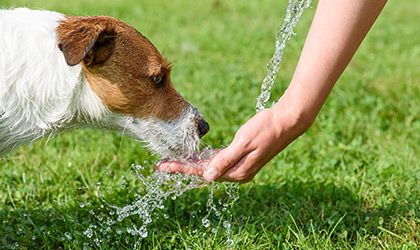
We’re in the tight grip of a global obesity epidemic – a grossly fat public health crisis that continues to grow in acuteness and severity. But this widespread phenomenon isn’t just affecting the human population – our four-legged friends are getting plumper too. According to the British Veterinary Association, an alarming 60% of pets are obesei. That’s no small figure to scoff at. Unsurprisingly, this explosion in obesity has become a top welfare concern for vets. As well as decreasing quality of life, excess weight can trigger a host of other serious health conditions such as arthritis, diabetes, high blood pressure and cancer. Trouble is, we can’t resist overfeeding our porky pooches and fat felines. Often, doting owners think they are showering their furry friends with love – little do they know, they’re actually killing them with ‘kindness’. Here’s why you should think twice before sharing that takeaway with your furry friend.
Decreased life expectancy
Overwhelming research points to obesity in pets reducing life expectancy. In fact, the growing girth of your furry friend could shave five to ten years off their lifeii. So if you’re searching for the so-called ‘Fountain of Youth’, we’d suggest looking straight to their food bowl for all the answers. Less is more if you want your pets to live longer – it’s as simple as that. While pet food packaging gives you a rough estimation on how much to feed your four-pawed friend, you shouldn’t just blindly follow it. Some serving size ranges can be monstrously wide. Instead, speak to your vet to clarify exactly how much you should be feeding your pet.
Arthritis
The chief co-morbidity associated with obesity is arthritis. And overweight pets are developing this crippling condition at a startling rateiii. Even carrying a couple of extra pounds can stress the teeny tiny joints of your furry friends. Worse still, fat cells emit ‘adipocytokines’ – toxic chemicals that can damage non-weight bearing joints. Sadly, arthritis a chronic, incurable condition; pain reduction is the only ‘solution’, which is all the more reason to keep your pet trim.
High blood pressure
High blood pressure is one of the most common conditions to afflict obese pets – and it’s one of the most overlooked tooiv. Otherwise known as the ‘silent killer’, this problem is extremely difficult to detect. There are no tell-tale signs – often you discover it when it’s too late. If your pet has piled on the pounds, get your vet to examine their blood pressure – a routine check-up that can prevent the onset of rapid heart problems, kidney failure and blindness. Thankfully, a low-sodium diet, increased exercise, and weight loss can help alleviate this potentially deadly problem.
Diabetes
Vets are seeing more and more cases of type 2 diabetes in overweight pets. Your fat friends are vulnerable to developing perilously high blood sugar and insulin levels, which can lead to diabetes. Not only can this condition be fatal, but it also requires life-long medication and attention. Many diabetic pets will need two insulin injections per day! Treatment is as simple as feeding your pets less to achieve a healthy weight. It couldn’t be easier, right?
Cancer
We’ve known that obesity is implicated in the development in some cancers for some time now. The National Cancer Institute surmises that physical inactivity and obesity is a causal factor for approximately 25%-30% of the most prominent cancers in humans: breast cancer, colon, endometrial, oesophagus and kidneyv. Though we don’t have a ton of pet-related studies to draw upon yet, the correlation between obesity and cancer risk is stark and will no doubt affect our furry friends too. The solution? Reduce your pet’s weight to reduce the cancer risk: simple.
Top tips on reducing obesity in pets
-
Know your pet’s optimal weight. Ideally, you want to be able to feel their ribs and spine ‘readily’, but you don’t want them to be prominent or stand out. You want them to have a waist too. Consult your vet if you need further clarification on how much your pet should weigh.
-
Refine diet. Use the pet food packaging to guide your portion size, but again – it’s worth discussing the specifics with your vet. Feed your pets at set times too to avoid free feeding. A little disclaimer: be mindful that dry cat food is loaded with calories, so you may want to switch to canned instead.
-
A resounding ‘no’ to unhealthy titbits. Cheese, crisps and cake are all off the menu for your pets – even that ‘innocent’ morsel of cheese. If you are going to give your companion a snack, ensure it’s of the healthy variety. Freeze-dried liver or lung treats are pretty good alternatives to unhealthy pet biscuits, as they’re crammed with protein and come in at only 10 calories a pop.
-
Get your pet moving. Exercise needs to more than just a leisurely amble around the block for your pooch. If you want your canine to lose weight and maintain it, you need to get them powerwalking or running. Try setting a pace of 15 minute per mile, and avoid sniffing and marking breaks – this will only slow you down. As for felines, it’s important to play with them for at least 10 minutes each day. Use a fishing-line to encourage your cat to dart, jump and pounce about – capitalise on their predatory nature to get them exercising.
Final thoughts
As their primary caregiver, your beloved companions rely on you to make healthy decisions for them. The bottom line is that you must value their nutritional needs: no more roast dinners, no more takeaways, and certainly no more cooked breakfasts. Ultimately, you need to be feeding your furry friends based on sound dietary advice – consulting your vet is a helpful place to start. If you take your pet’s waistline seriously, their happiness, health and longevity will thank you for it.
References:
-
British Veterinary Association. (2016). Pet obesity is a top welfare concern for pets. Available online: https://www.bva.co.uk/news-campaigns-and-policy/newsroom/news-reeases/pet-obesity-epidemic-is-top-welfare-concern-for-vets/.
-
Sandøe, P., et al. (2014). Canine and feline obesity: a One Health perspective. Veterinary Record., 175(24), 610 - 616
-
German, A.J. (2016). Weight management in obese pets: the tailoring concept and how it can improve results. Acta Veterinaria Scandinavica. 58(Suppl 1), 57.
-
Alberto Montoya, J., et al. (2003). Hypertension: A Risk Factor Associated with Weight Status in Dogs. The Journal of Nutrition. 136 (7) 2011S–2013S.
-
National Cancer Institute. (2018). Obesity and Cancer. Available online: https://www.cancer.gov/about-cancer/causes-prevention/risk/obesity/obesity-fact-sheet



